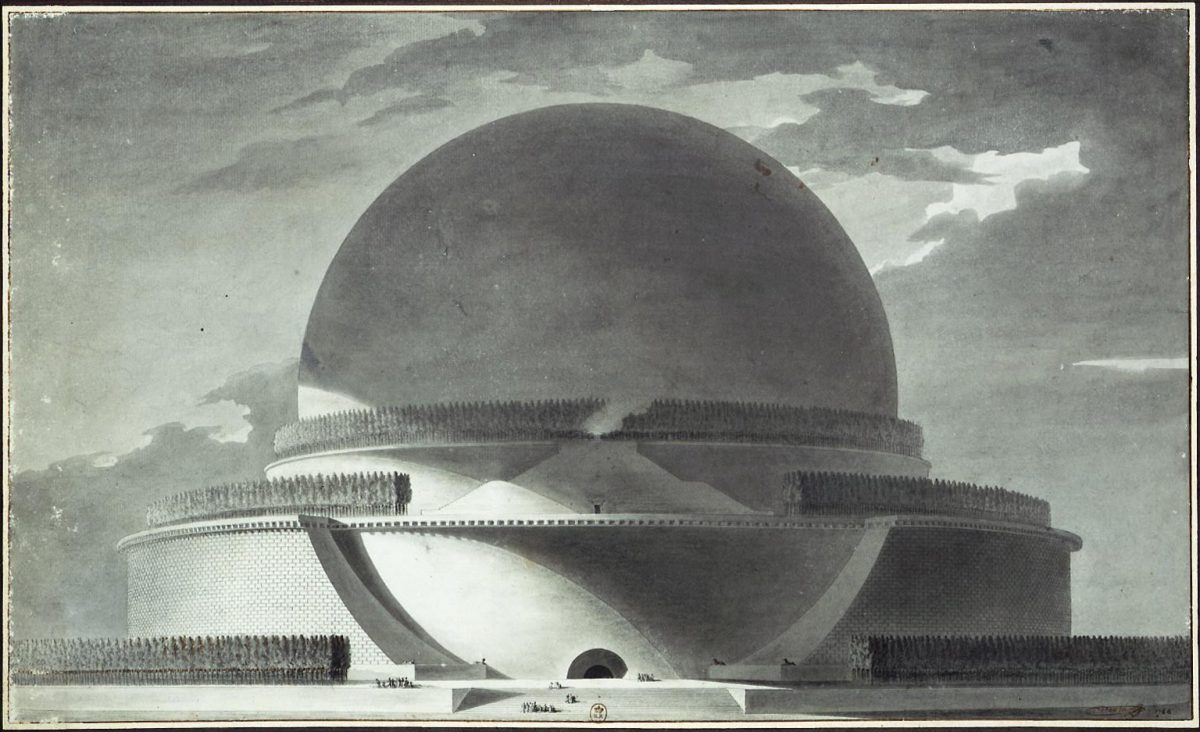A 500ft sphere — the proposed resting place for English physicist and mathematician Sir Isaac Newton — was designed by French architect Étienne-Louis Boullée in 1784.1 Boullée’s Cenotaph for Newton is rooted in the architecture of multiple cultures, the project context is disregarded, and the reconstruction of nature dominates ideological understandings of the architecture. Therefore, the Cenotaph for Newton connects to themes of empire and colonialism because of the significance of scientific enlightenment and idolization of western knowledge within the design. While this design was never built and exists only as paper architecture, the fundamental beliefs that contributed to this design are inherently westernized, epitomizing the fundamentals of European empire and colonization during the 1700-1800s. Ultimately, the Cenotaph for Newton is as much a monument to western knowledge as it is to Sir Isaac Newton. In the context of this paper, western knowledge relates to historical understandings of the global west, encompassing western Europe and North America.
When regarding the cenotaph, it is necessary to recognize the entire narrative surrounding this project: the favourable sentiments and the complete veracity. In the case of the Cenotaph for Newton, within the discipline of architecture, summaries of the project often focus on the formal design. Idealization occurs, which limits the discussion surrounding the narratives that are excluded or withheld in the project: the origins of ‘exotic’ — referring the historical perception of cultures outside of the global west — as well as a human-centric approach to context and manipulation of ‘nature.’ Therefore, while the project is a monument to scientific thought, and western thought in general, one can offer a critique of the cenotaph which connects to a larger theme and doctrine specific to European empire and colonialism.
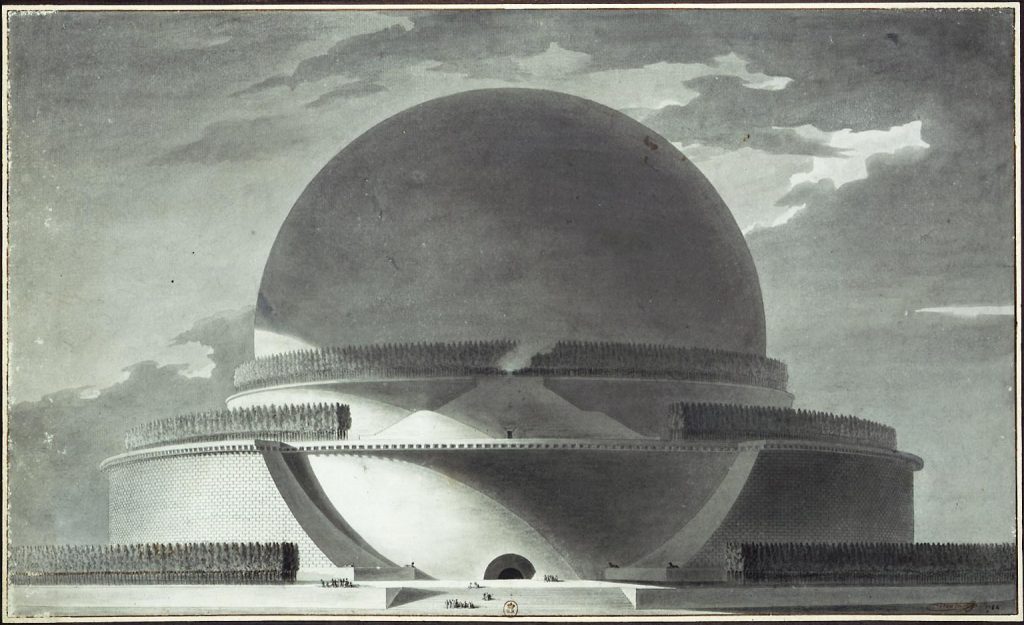
Before interlacing ideas of colonialism and empire, it is necessary to first understand the design for the cenotaph and the fundamental ideas that drove the concept of Boullée’s architecture. The exterior elevation of the cenotaph (fig. 1) depicts a large spherical structure set into a base with three-tiered concentric levels, each containing a ring of carefully pruned cypress trees, which references mourning traditions in classical antiquity.2 An expansive set of steps leads to a domed entrance on the bottom level, and a small doorway appears directly above on the facade of the second terrace level. The interior space of the sphere, seen in section (fig. 2), shows a large void carved out of the spherical mass.3 At the bottom of the sphere, steps lead up to a tomb, which appears small relative to the surrounding architecture. Small funnel openings pierce the envelope of the sphere, allowing tiny pinholes of daylight to enter the dimly lit interior.4
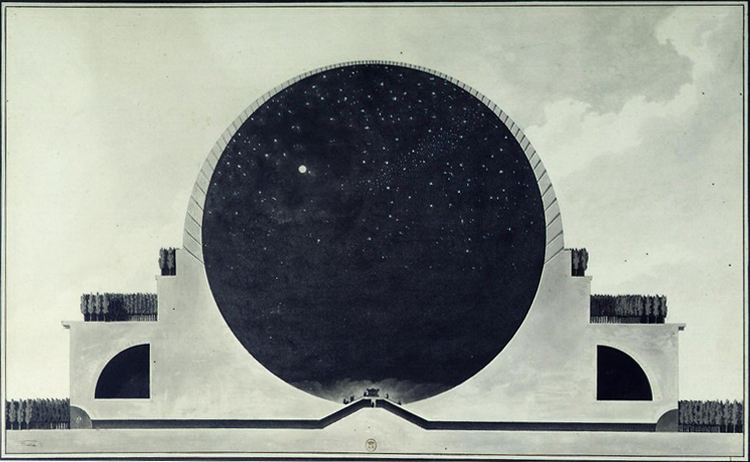
All of the drawings are black and white and use significant shading techniques to produce shadows — emphasizing a contrast between the dichotomy of light and dark — to communicate the design of the cenotaph. The proposal has very little ornamentation, except for a cornice on the top of the first level, which is reminiscent of a cornice within a classical entablature. The overall design is monumental but minimal, which relates to Boullée’s methodology of being a reductionist, as discussed by scholar Robin Middleton in Boullée and the Exotic (1990): “to reduce not only the complexities of geometry, but also the complexities of knowledge, understanding and feeling, to the simplest of forms. His was a reductionist ethos, though he hoped that nothing would thereby be lost.”5
Middleton also discusses the theme of Boullée’s obsession with the architecture of death, namely Egyptian pyramids, and Middleton notes the transformation of the “exotic into firm geometrical form.”6 An example of this is another cenotaph designed by Étienne-Louis Boullée (fig. 3), which shows a truncated cone, with a schema similar to the Cenotaph for Newton. The pyramidal shape of the cenotaph directly correlates to Egyptian pyramids. This reference is often not mentioned within descriptions of the Cenotaph for Newton, other than as a comparison for the monumental scale of the design.
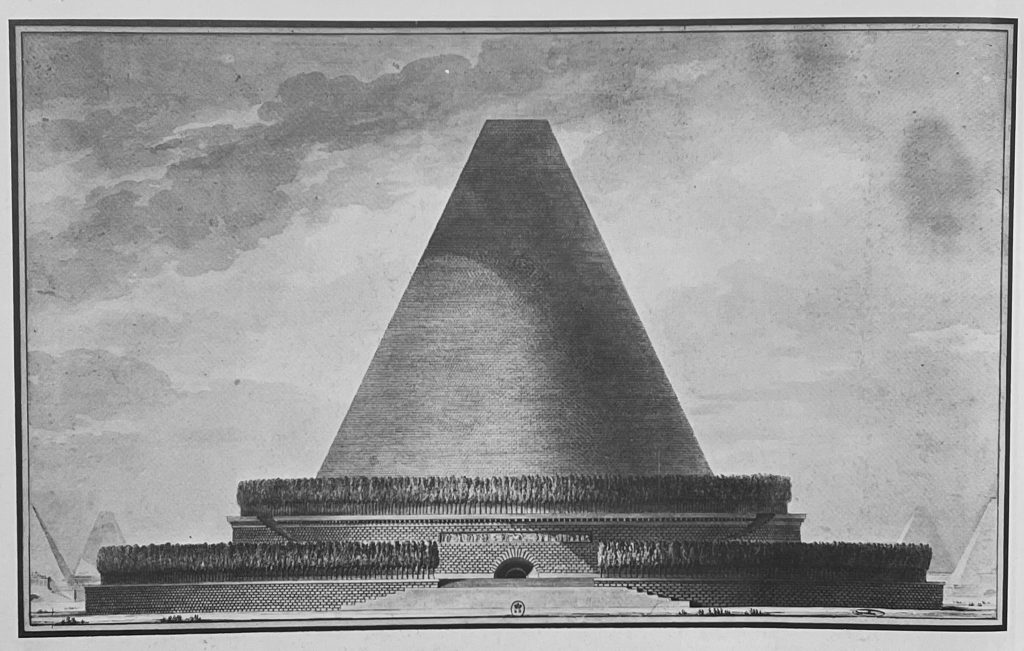
Another observation when looking at Boullée’s drawings is the lack of context represented alongside the cenotaph. While the project was never built on a site and exists only on paper, the drawings of the cenotaph do not depict a surrounding context. Middleton notes: “Boullée has also eliminated, in his drawings, all overt reference to the natural world; his buildings are set on a tabula rasa.”7 While Middleton writes that Boullée eliminates all reference to the natural world, one can note the subtle clouds looming behind the cenotaph, which means Boullée did consider the natural context, but only when it suits his proposal. Outside of the typical Cenotaph for Newton drawing set, Boullée depicts the context of Landscape with Central Cenotaph (fig. 4) in an idealistic manner, as if to imply his design are as grandiose as the natural world, or that they are in dialogue with the natural world.

In Architecture, Essai sur l’art Boullée writes: “Nature is adorned with a multitude of beautiful things and offers us a splendid vista of magnificence.”8 Within this quote, one can note Boullée’s understanding of nature occurs in relation to the human. Subsequently, Boullée describes how perfect reproductions of nature can occur within his architecture, with a specific example being funnel-like openings in the ceiling which create pinhole lights in the ceiling during the day, mimicking constellations.9 It is unclear whether these artificial “stars” would represent accurate placements of real stars and planets, or would simply offer a poetic experience to visitors — in either case, Boullée is choosing to place his architecture between the inhabitant and the actual sky, to reconstruct nature, instead of using his design to frame the nature that already exists. A giant glowing orb replicates the sun during the night, inverting the natural cycle of night and day within the cenotaph (fig. 5).10 Ultimately, Boullée proposes spaces that manipulate and replicate nature for the benefit of human experience — an inherently anthropocentric approach that ties closely to the methodologies of empire and colonialism.
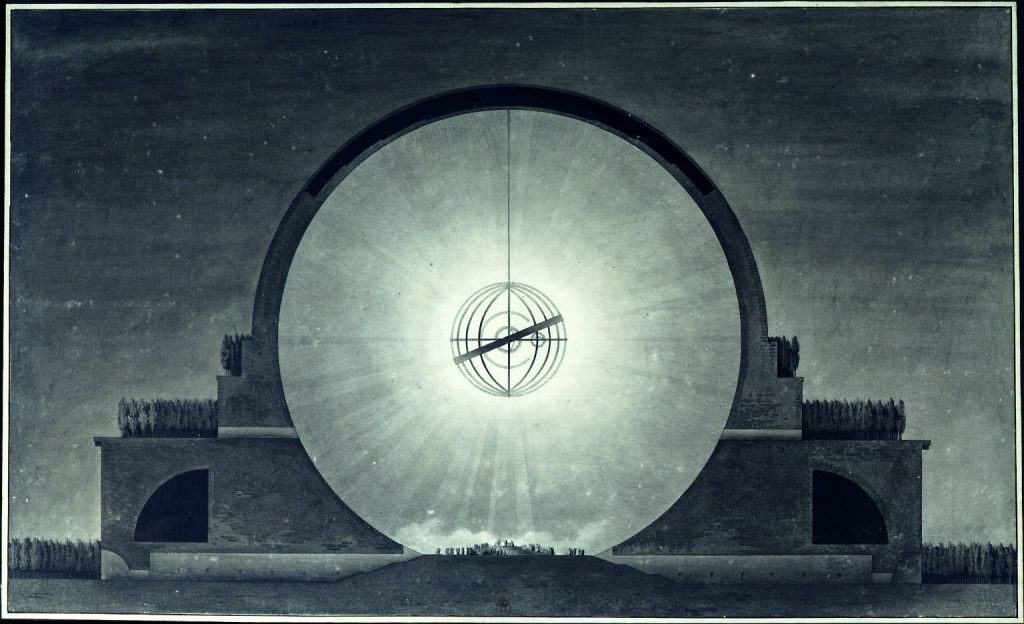
The choice of creating a cenotaph for Sir Isaac Newton can also correlate to the theme of empire and colonialism. Newton was a prominent enlightenment thinker, and Neil Levine, author of the book Modern Architecture: Representation and Reality (2009), describes Boullée’s muse as:
“The choice of subject was fraught with significance. By the later 19th century, Newton has become a symbol par excellence of the enlightenment. In Boullée’s eyes, he was the ultimate expression of the human capacity to understand and control the natural order of the universe. Newton was therefore the perfect subject for an architecture of the totalizing sort Boullée had in mind.”11
The scientific discoveries of Isaac Newton are irrefutably a fundamental pillar of our current society, as Newton is a founder of calculus.12 Étienne-Louis Boullée greatly admires Newton’s achievements and uses the magnitude of his discoveries to justify the monumental scale of the cenotaph.13 A glorification of Newton’s discoveries occurs in Boullée’s design, notably using the sphere geometry: “Since the enlightened scientist and mathematician had ‘determined the figure of the earth’ the only form of artistic acknowledgement that would be “worthy” of him was to envelope him in his own discovery.”14 Overall, the Cenotaph for Newton is a piece of architecture to commemorate Newton, and arguably more important to Boullée, Newton’s scientific discoveries. As such, the Cenotaph for Newton is not only a monument to Isaac Newton but to the more significant embodiment of scientific knowledge. When considering empire and colonialism, the utilization of western scientific knowledge correlates to the “White Man’s Burden” — a highly problematic notion that western societies need to spread their knowledge in order to civilize the communities encountered during colonization.15 Therefore, while Cenotaph for Newton is commemorating the monumental discoveries of Isaac Newton, it is also more generally commemorating the discipline of science, which can correlate — both positively and negatively — to empire and colonialism.
Understanding the architectural training received by Boullée can give insight into his ideological stance regarding the design of his buildings. Neil Levine notes: “Laugier’s theory of the natural origin of the Greek temple in the primitive hut would provide Boullée with a basis for his own interpretation of the mimetic and would eventually be be inscribed in Boullée’s pedagogical program as the foundation of architectural education.”16 Using the primitive hut as a basis for architectural understandings is a highly westernized perception of architecture, similar to Sir Banister Fletcher’s The Tree of Architecture, as it selectively ignores architecture from different and expansive areas of the world.
As an individual writing during the first quarter of the 21st century, the notion of the Anthropocene is ever-pressing. It is important to acknowledge my implicit bias while reflecting upon past architecture and holding Boullée’s designs to today’s standards. In countless ways, the designs and writings of Etienne Louis Boullée have immensely contributed to furthering the discipline of Architecture. Ultimately, it is the prescription of an academic to question, critique, and reconsider our predecessors. Boullée notes, “These monuments should therefore be designed to withstand the ravages of time.”17 While it is unclear whether Boullée indicates material durability or cultural fortitude and relevance, one can interpret Boullée as emphasizing the importance of his monuments to withstand cultural relevance throughout time. While the aim of this paper was to highlight Boullée’s cenotaph in a critical light, the cenotaph still remains culturally relevant, even though the project exists as an unbuilt project.
The idolization of Isaac Newton through the perspective of Étienne-Louis Boullée’s cenotaph design correlates to the empire built in the wake of Newton’s logic. The cenotaph is a monument to scientific thought, and while the intention is to recognize the positive attributes of Newton’s discoveries, the adverse effects of the scientific pedagogy, which relate to empire and colonialism, are equally signified in the architecture — albeit this notion is only possible to comprehend upon reflection 237 years after. Ultimately, architectural projects are constantly undergoing re-contextualization as the social and environmental contexts evolve. In order to learn from past designs, this process of evaluation, re-contextualization, and critique is necessary to create future designs that are more inclusive and equitable.
Footnotes
1 Neil Levine. Modern Architecture: Representation & Reality. New Haven: Yale University Press, 2009, 86-90.
2 Helen Rosenau and Etienne Louis Boullée. Boullée & Visionary Architecture. London: New York: Academy Editions; Harmony Books, 1976, 106.
3 Darell Wayne Fields. Architecture in Black: Theory, Space and Appearance. Second edition. London ; New York: Bloomsbury, 2015,187.
4 Rosenau, 107.
5 Robin Middleton. “Boullée and the Exotic.” AA Files: Architectural Association School of Architecture No. 19, no. Spring 1990 (1990): 35–49, 48.
6 Ibid
7 Ibid
8 Rosenau, 89
9 Rosenau, 107
10 Ibid
11 Neil Levine. Modern Architecture: Representation & Reality. New Haven: Yale University Press, 2009, 86
12 Arthur Rosenthal. “The History of Calculus.” The American Mathematical Monthly 58, no. 2 (February 1951): 75–86. https://doi.org/10.1080/00029890.1951.11999628, 75.
13 Levine, 86
14 Levine, 87
15 Fordham University. “Rudyard Kipling, The White Man’s Burden, 1899,” August 1997. https://sourcebooks.fordham.edu/mod/kipling.asp.
16 Levine, 80
17 Rosenau, 105
Bibliography
Fields, Darell Wayne. Architecture in Black: Theory, Space and Appearance. Second edition. London ; New York: Bloomsbury, 2015.
Levine, Neil. Modern Architecture: Representation & Reality. New Haven: Yale University Press, 2009.
Middleton, Robin. “Boullée and the Exotic.” AA Files: Architectural Association School of Architecture No. 19, no. Spring 1990 (1990): 35–49.
Rosenau, Helen, and Etienne Louis Boullée. Boullée & Visionary Architecture. London: New York: Academy Editions; Harmony Books, 1976.
Rosenthal, Arthur. “The History of Calculus.” The American Mathematical Monthly 58, no. 2 (February 1951): 75–86. https://doi.org/10.1080/00029890.1951.11999628.
Fordham University. “Rudyard Kipling, The White Man’s Burden, 1899,” August 1997. https://sourcebooks.fordham.edu/mod/kipling.asp.
